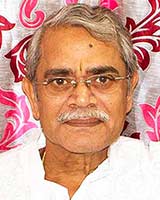Macnaghten’s successor, Major Eldred Pottinger, wanted to break off all negotiations with the Afghans and either to occupy the Bala Hissar, and hold out till help came or to proceed to Jalalabad which was bravely defended by Sale. But Elphinstone and other military officers, who had not the courage to stand and vindicate their national honour, disregarded his suggestions and stooped to make more concessions. They surrendered guns, muskets and ordnance stores and ratified the treaty on the lst January, 1842. On the 6th January, the “crouching, drooping and dispirited” British troops and camp-followers, 16,500 men in all, set out on their return journey towards India, struggling through the stinging snow of the winter and a constant shower of bullets from the Afghans, whose fanatical rage Akbar Khan was unable to check. Within a few days the women and children and some officers, including Pottinger, Lawrence and Elphinstone, were given to Akbar Khan as hostages. But the slaughter of British troops continued and on the 10th January only about a quarter of the force was left. In the pithy phrase of Roberts, ” the retreat became a rout, the rout a massacre.” Thus considerably thinned, the retiring troops made the last desperate stand at the Pass of Jagdalak on the 11th January only to lose twelve of their officers. Of the 16,500 men that had started from Kabul a week before, all were destroyed excepting 120 prisoners under Akbar Khan, and only one, Dr. Brydon, reached Jalalabad, severely wounded and utterly exhausted, on the 13th January, to narrate the painful story of the tragic retreat. The gallant defence of Qandahar by Nott and Rawlinson and of Jalalabad by Sale and Broadfoot, may be considered as the only streak of light in the enveloping darkness of disaster. Naturally shocked and mortified by these calamities, Lord Auckland tried to conceal his lack of foresight by describing the terrible catastrophe in the General Order issued on the 31st January as “a partial reverse”, which afforded “a new occasion for displaying the stability and vigour of the British power, and the admirable spirit and valour of the British-Indian army”. He made some ill-fated efforts to retrieve British prestige, but was soon compelled to leave his office, and Lord Ellenborough (1842-1844) took charge of it on the 28th February, 1842.
There is no doubt that the Afghan War was an unjust proceeding on the part of the Company’s Government in India, and as such it merited, in the opinion of some writers, the ” tremendous Nemesis” which overtook it. Kaye significantly observes: . . . the wisdom of our statesmen is but foolishness, and the might of our armies is but weakness when the curse of God is sitting heavily upon an unholy cause.” Further, the feeble and unwise manner in which it was conducted made its failure inevitable. In critically examining the causes of the British reverses and disasters in connection with the Afghan War, Captain Trotter remarks that “the utter collapse of that (Lord Auckland’s) policy, baleful, lawless, and blundering as it was, sprang mainly from the choice of agents ill-fitted for their work. Macnaghten’s cheery trustfulness, Elphinstone’s bodily and mental decay, Shelton’s stupid wilfulness, chronic dissensions between the civil and military powers, Sale’s withholding of timely succour, all conspired with Lord Auckland’s half-measures and ill-timed economies, to work out the dramatic Nemesis of an enterprise begun in folly and wrong-doing “.
Lord Ellenborough (1842-1844) and Afghan Affairs
In view of the overwhelming disaster of the late Afghan War, Lord Ellenborough declared in a letter to the Commander-in-Chief, written on the 15th March, 1842, that the British Government would no longer “peril its armies and with its armies the Indian Empire” to support the Tripartite Treaty, but would aim at the establishment of its military reputation “by the infliction of some signal and decisive blow upon the Afghans “. He changed this resolution, however, on hearing the news of General England’s defeat at Hakalzai and Palmer’s surrender of Ghazni, and ordered the immediate withdrawal of the British troops that still remained in Afghanistan, without thinking any longer of reprisals or of releasing the prisoners. This order fell on the army, as Outram recorded, “like a thunder-clap ” and raised a storm of indignation both in England and India. Shah Shuja had meanwhile been murdered. Both Nott and Pollock showed no disposition to retire but maintained their positions, pleading want of transport as a reason for their hesitation to withdraw. Lord Ellenborough at last “discovered a way to maintain a particularly empty show of consistency, and at the same time to satisfy the universal demand for the decisive reconquest of Kabul and recovery of the prisoners as a preliminary to withdrawal”. On the 4th July he sent letters to Nott and Pollock repeating the order for withdrawal from Afghanistan, but at the same time gave Nott wide discretion to retire to India, not by the Bolan Pass, but by Ghazni and Kabul through the Khyber, and also ordered Pollock to act in concert with Nott in this matter of retreat. It is clear that the Governor-General thus threw the responsibility for decision on the generals, who, however, accepted it without any hesitation. On the 20th August, Pollock started from Jalalabad with 8,000 of his choice troops; defeated the Afghans at Jagdalak on the 8th September and at Tezin on the 13th September, reached Kabul on the 15th September and once more hoisted the British flag at the Bala Hissar. On the 17th September he joined Nott, who had already destroyed the town and fortifications of Ghazni on the 6th September and had, according to the instructions of Lord Ellenborough, carried away the “so-called gates of Somnath”, which Sultan Mahmud was supposed to have carried off in the eleventh century. The English prisoners were rescued; but “the glory of the avenging army at Kabul was marred by acts of barbarity” when it blew up the great bazar of Kabul with gunpowder and the city was ruthlessly sacked, many inoffensive people being subjected to great suffering, before it was evacuated on the 12th October. The returning army was welcomed by the Governor-General at Ferozepore with ” triumphal arches and histrionic paeans of victory”. In a proclamation issued from Simla on the 10th October, though it was dated the 1st October, Lord Ellenborough denounced in strong language the policy of his predecessor and expressed his willingness “to recognize any government approved by the Afghans themselves, which shall appear desirous and capable of maintaining friendly relations with neighbouring States”. In another bombastic proclamation, addressed to the princes, chiefs and people of India, the Governor-General announced: “Our victorious army bears the gates of the temple of Somnath in triumph from Afghanistan and the despoiled tomb of Sultan Mahomed looks upon the ruins of Ghaznee. The insult of 800 years is avenged.”
The unwisdom and uselessness of the second proclamation can hardly be doubted. “The folly of the thing,” observes Kaye, “was past all denial. It was a folly, too, of the most senseless kind, for it was calculated to please none and to offend many.” It wounded the feelings of the Muslims; and the Hindus remained indifferent about the gates, which, as the antiquarians rightly held, had been built much later than the eleventh century “of no wood more precious than deal or deodar”. The Governor-General’s “glorious trophy of a successful war” was in the end consigned to a lumber-room in the fort of Agra, and he made himself subject to ridicule and censure, though he was powerfully supported by the Duke of Wellington and Lord Hardinge. Dost Muhammad was allowed to reoccupy his throne unconditionally, and he held it till his death, at the age of eighty, in 1863. His friendly attitude towards the English and opposition to Persia showed that the “whole disastrous episode”, which cost no less than 20,000 human lives and fifteen millions of money, was entirely superfluous
The Annexation of Sind
The Afghan War was very closely connected with the conquest of Sind, which followed it. Sind embraced the lower valley of the Indus and was included within the empire of Ahmad Shah Durrani. But, during the closing years of the eighteenth century, it owed only a nominal allegiance to Afghanistan and was governed in practical independence by the Mirs or Amirs of the Talpura, tribe, which, coming originally from Baluchistan, had overthrown the last of the Kaloras in A.D. 1783. The three important branches of the Talpura chiefs were seated at Hyderabad, Khairpur and Mirpur.
The English had commercial interests in Sind for a long time; a factory established by them at Thatta in 1768 was abandoned in 1775 and their commercial mission to the Talpura Mirs in 1799 produced no important result. With a view to excluding French influence from Sind, the British Government concluded a treaty with the Amirs of Sind in 1809, which was renewed in 1820. The journey of Alexander Burnes in 1831 up the river Indus on his way to Lahore disclosed to the English the importance of Sind from the political as well as commercial point of view, and since then its absorption into the growing British Empire had been only a question of time. “Alas,” observed a Seiad, “Sind is now gone since the English have seen the river.” As we shall see, this proved wholly true as a prophetic prediction.











